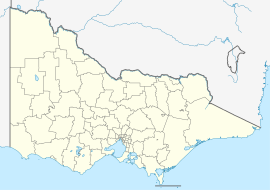History
The passing of the Country Roads Act of 1912 [5] through the Parliament of Victoria provided for the establishment of the Country Roads Board (later VicRoads) and their ability to declare Main Roads, taking responsibility for the management, construction and care of the state's major roads from local municipalities. Inverloch-Leongatha Road from Inverloch to Leongatha, and Inverloch-Wonthaggi Road from Inverloch to Wonthaggi, were declared Main Roads on 10 November 1913, [2] and (Main) Coast Road from Lang Lang to Anderson (and continuing west to San Remo), was declared a Main Road on 7 September 1914. [6]
The passing of the Highways and Vehicles Act of 1924 [7] through the Parliament of Victoria provided for the declaration of State Highways, roads two-thirds financed by the State government through the Country Roads Board. Bass Highway was declared a State Highway in the 1947/48 financial year, [3] from South Gippsland Highway near Nyora via Anderson, and Dalyston to Wonthaggi (for a total of 30 miles), subsuming the original declaration of (Main) Coast Road as a Main Road; before this declaration, the roads were also referred to as Anderson–Dalyston Road and Dalyston–Wonthaggi Road. [8] In the 1959/60 financial year, its eastern end was extended from Wonthaggi to Inverloch, [9] subsuming the original declaration of Inverloch-Wonthaggi Road as a Main Road. The passing of the Transport Act of 1983 [10] updated the definition of State Highways; the highway was extended east one last time from Inverloch to Leongatha in December 1990, [11] subsuming the original declaration of Inverloch-Leongatha Road as a Main Road and completing its present-day alignment at this stage.
Bass Highway was signed as State Route 181 between Lang Lang and Wonthaggi in 1986, [12] later extended with the road to Leongatha in 1990. With Victoria's conversion to the newer alphanumeric system in the late 1990s, this was replaced by route M420 between Lang Lang and Grantville, A420 between Grantville and the Phillip Island turn-off at Anderson, and B460 between Anderson and Leongatha. A duplication project improving the quality of the road upgraded the A420 allocation to M420 in 2013, now running the entire way between Lang Lang and a new link road to Phillip Island in south-western Bass. [13]
The passing of the Road Management Act 2004 [14] granted the responsibility of overall management and development of Victoria's major arterial roads to VicRoads: in 2004, VicRoads re-declared the road as Bass Highway (Arterial #6710) between South Gippsland Highway in Lang Lang and Leongatha. [4]
Duplication towards Phillip Island
A project to duplicate Bass Highway from Lang Lang to Bass (east of Phillip Island) commenced in the late 1990s, addressing the high traffic demand of the route and recent crash history. It was constructed in seven stages, with Stage 7 of the project from Woolmer Road to Phillip Island Road completed in 2013.
The benefits of this project include:
- reduced travel times to Phillip Island which hosts some of Victoria's favourite tourist and sporting attractions
- eliminating use of the roundabout at Anderson, and providing a direct route between Melbourne and Phillip Island
- bypassing a winding section of Phillip Island Road and providing two added lanes along Bass Highway. This will help address the crash history in this area. There have been 13 crashes in a recent five-year period.
- an overpass, which will be constructed near Netherwood will provide smoother and safer movements at the connection of the Bass Highway and the new link road, for Phillip Island and Wonthaggi-bound traffic
- helping traffic to exit Phillip Island after major events such as the MotoGP
The project was completed in 2013. [13]
This page is based on this
Wikipedia article Text is available under the
CC BY-SA 4.0 license; additional terms may apply.
Images, videos and audio are available under their respective licenses.

